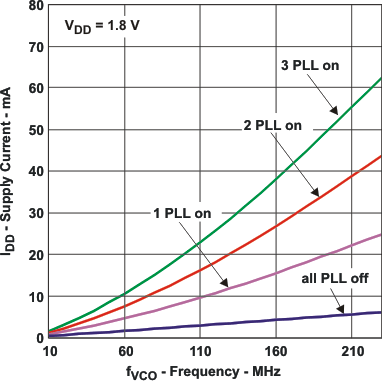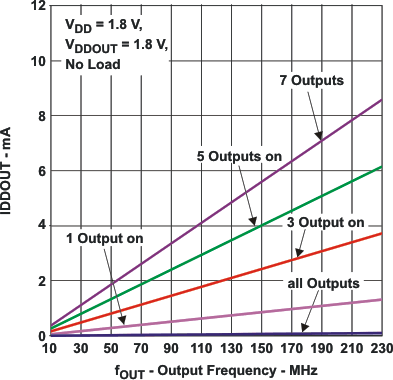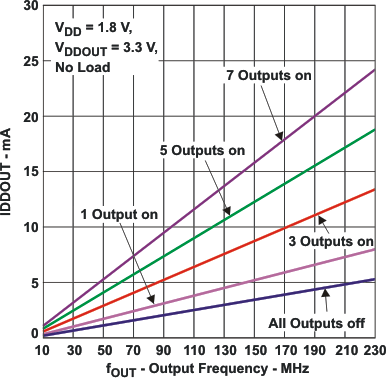SLAS564G August 2007 – October 2016 CDCE937 , CDCEL937
PRODUCTION DATA.
- 1 Features
- 2 Applications
- 3 Description
- 4 Revision History
- 5 Pin Configuration and Functions
- 6 Specifications
- 7 Parameter Measurement Information
- 8 Detailed Description
- 9 Application and Implementation
- 10Power Supply Recommendations
- 11Layout
- 12Device and Documentation Support
- 13Mechanical, Packaging, and Orderable Information
Package Options
Mechanical Data (Package|Pins)
- PW|20
Thermal pad, mechanical data (Package|Pins)
- PW|20
Orderable Information
6 Specifications
6.1 Absolute Maximum Ratings
over operating free-air temperature range (unless otherwise noted)(1)| MIN | MAX | UNIT | |
|---|---|---|---|
| Supply voltage, VDD | –0.5 | 2.5 | V |
| Input voltage, VI(2)(3) | –0.5 | VDD + 0.5 | V |
| Output voltage, VO(2) | –0.5 | Vddout + 0.5 | V |
| Input current, II (VI < 0, VI > VDD) | 20 | mA | |
| Continuous output current, IO | 50 | mA | |
| Junction temperature, TJ | 125 | °C | |
| Storage temperature, Tstg | –65 | 150 | °C |
(1) Stresses beyond those listed under Absolute Maximum Ratings may cause permanent damage to the device. These are stress ratings only, which do not imply functional operation of the device at these or any other conditions beyond those indicated under Recommended Operating Conditions. Exposure to absolute-maximum-rated conditions for extended periods may affect device reliability.
(2) The input and output negative voltage ratings may be exceeded if the input and output clamp-current ratings are observed.
(3) SDA and SCL can go up to 3.6 V as stated in Recommended Operating Conditions.
6.2 ESD Ratings
| VALUE | UNIT | |||
|---|---|---|---|---|
| V(ESD) | Electrostatic discharge | Human-body model (HBM), per ANSI/ESDA/JEDEC JS-001(1) | ±2000 | V |
| Charged-device model (CDM), per JEDEC specification JESD22-C101(2) | ±1500 | |||
(1) JEDEC document JEP155 states that 500-V HBM allows safe manufacturing with a standard ESD control process.
(2) JEDEC document JEP157 states that 250-V CDM allows safe manufacturing with a standard ESD control process.
6.3 Recommended Operating Conditions
| MIN | NOM | MAX | UNIT | |||
|---|---|---|---|---|---|---|
| VDD | Device supply voltage | 1.7 | 1.8 | 1.9 | V | |
| VO | Output Yx supply voltage, Vddout | CDCE937 | 2.3 | 3.6 | V | |
| CDCEL937 | 1.7 | 1.9 | ||||
| VIL | Low-level input voltage LVCMOS | 0.3 × VDD | V | |||
| VIH | High-level input voltage LVCMOS | 0.7 × VDD | V | |||
| VI(thresh) | Input voltage threshold LVCMOS | 0.5 × VDD | V | |||
| VIS | Input voltage | S0 | 0 | 1.9 | V | |
| S1, S2, SDA, SCL, VI(thresh) = 0.5 VDD |
0 | 3.6 | ||||
| VI(CLK) | Input voltage, CLK | 0 | 1.9 | V | ||
| IOH /IOL | Output current | Vddout = 3.3 V | ±12 | mA | ||
| Vddout = 2.5 V | ±10 | |||||
| Vddout = 1.8 V | ±8 | |||||
| CL | Output load LVCMOS | 10 | pF | |||
| TA | Operating free-air temperature | –40 | 85 | °C | ||
| CRYSTAL AND VCXO(1) | ||||||
| fXtal | Crystal input frequency (fundamental mode) | 8 | 27 | 32 | MHz | |
| ESR | Effective series resistance | 100 | Ω | |||
| fPR | Pulling (0 V ≤ Vctrl ≤ 1.8 V)(2) | ±120 | ±150 | ppm | ||
| Frequency control voltage, Vctrl | 0 | VDD | V | |||
| C0/C1 | Pullability ratio | 220 | ||||
| CL | On-chip load capacitance at Xin and Xout | 0 | 20 | pF | ||
(1) For more information about VCXO configuration, and crystal recommendation, see VCXO Application Guideline for CDCE(L)9xx Family (SCAA085).
(2) Pulling range depends on crystal-type, on-chip crystal load capacitance and PCB stray capacitance; pulling range of min ±120 ppm applies for crystal listed in VCXO Application Guideline for CDCE(L)9xx Family (SCAA085).
6.4 Thermal Information
| THERMAL METRIC(1) | CDCE937, CDCEL937 |
UNIT | |
|---|---|---|---|
| PW (TSSOP) | |||
| 20 PINS | |||
| RθJA | Junction-to-ambient thermal resistance | 89.04 | °C/W |
| RθJC(top) | Junction-to-case (top) thermal resistance | 31.33 | °C/W |
| RθJB | Junction-to-board thermal resistance | 54.6 | °C/W |
| ψJT | Junction-to-top characterization parameter | 0.8 | °C/W |
| ψJB | Junction-to-board characterization parameter | 48.8 | °C/W |
| RθJC(bot) | Junction-to-case (bottom) thermal resistance | — | °C/W |
(1) For more information about traditional and new thermal metrics, see the Semiconductor and IC Package Thermal Metrics application report.
6.5 Electrical Characteristics
over recommended operating free-air temperature range (unless otherwise noted)| PARAMETER | TEST CONDITIONS | MIN | TYP(1) | MAX | UNIT | ||
|---|---|---|---|---|---|---|---|
| IDD | Supply current (see Figure 1) | All outputs off, f(CLK) = 27 MHz, f(VCO) = 135 MHz |
All PLLS on | 29 | mA | ||
| Per PLL | 9 | ||||||
| IDDOUT | Output supply current (see Figure 2 and Figure 3) |
No load, all outputs on, fOUT = 27 MHz |
CDCE937, VDDOUT = 3.3 V |
3.1 | mA | ||
| CDCEL937, VDDOUT = 1.8 V |
1.5 | ||||||
| IDD(PD) | Power-down current | Every circuit powered down except SDA/SCL, fIN = 0 MHz, VDD = 1.9 V |
50 | µA | |||
| V(PUC) | Supply voltage Vdd threshold for power-up control circuit | 0.85 | 1.45 | V | |||
| f(VCO) | VCO frequency range of PLL | 80 | 230 | MHz | |||
| fOUT | LVCMOS output frequency | Vddout = 3.3 V | 230 | MHz | |||
| Vddout = 1.8 V | 230 | ||||||
| LVCMOS PARAMETER | |||||||
| VIK | LVCMOS input voltage | VDD = 1.7 V, II = –18 mA | –1.2 | V | |||
| II | LVCMOS Input current | VI = 0 V or VDD, VDD = 1.9 V | ±5 | µA | |||
| IIH | LVCMOS Input current for S0/S1/S2 | VI = VDD, VDD = 1.9 V | 5 | µA | |||
| IIL | LVCMOS Input current for S0/S1/S2 | VI = 0 V, VDD = 1.9 V | –4 | µA | |||
| CI | Input capacitance at Xin/Clk | VI(Clk) = 0 V or VDD | 6 | pF | |||
| Input capacitance at Xout | VI(Xout) = 0 V or VDD | 2 | |||||
| Input capacitance at S0/S1/S2 | VIS = 0 V or VDD | 3 | |||||
| CDCE937 – LVCMOS FOR Vddout = 3.3 V | |||||||
| VOH | LVCMOS high-level output voltage | Vddout = 3 V, IOH = –0.1 mA | 2.9 | V | |||
| Vddout = 3 V, IOH = –8 mA | 2.4 | ||||||
| Vddout = 3 V, IOH = –12 mA | 2.2 | ||||||
| VOL | LVCMOS low-level output voltage | Vddout = 3 V, IOL = 0.1 mA | 0.1 | V | |||
| Vddout = 3 V, IOL = 8 mA | 0.5 | ||||||
| Vddout = 3 V, IOL = 12 mA | 0.8 | ||||||
| tPLH, tPHL | Propagation delay | All PLL bypass | 3.2 | ns | |||
| tr/tf | Rise and fall time | Vddout = 3.3 V (20%–80%) | 0.6 | ns | |||
| tjit(cc) | Cycle-to-cycle jitter(2)(3) | 1 PLL switching, Y2-to-Y3 | 60 | 90 | ps | ||
| 3 PLL switching, Y2-to-Y7 | 100 | 150 | |||||
| tjit(per) | Peak-to-peak period jitter(3) | 1 PLL switching, Y2-to-Y3 | 70 | 100 | ps | ||
| 3 PLL switching, Y2-to-Y7 | 120 | 180 | |||||
| tsk(o) | Output skew(4) (see Table 2) | fOUT = 50 MHz, Y1-to-Y3 | 60 | ps | |||
| fOUT = 50 MHz, Y2-to-Y5 | 160 | ||||||
| odc | Output duty cycle(5) | fVCO = 100 MHz, Pdiv = 1 | 45% | 55% | |||
| CDCE937 – LVCMOS FOR Vddout = 2.5 V | |||||||
| VOH | LVCMOS high-level output voltage | Vddout = 2.3 V, IOH = –0.1 mA | 2.2 | V | |||
| Vddout = 2.3 V, IOH = –6 mA | 1.7 | ||||||
| Vddout = 2.3 V, IOH = –10 mA | 1.6 | ||||||
| VOL | LVCMOS low-level output voltage | Vddout = 2.3 V, IOL = 0.1 mA | 0.1 | V | |||
| Vddout = 2.3 V, IOL = 6 mA | 0.5 | ||||||
| Vddout = 2.3 V, IOL = 10 mA | 0.7 | ||||||
| tPLH, tPHL | Propagation delay | All PLL bypass | 3.4 | ns | |||
| tr/tf | Rise and fall time | Vddout = 2.5 V (20%–80%) | 0.8 | ns | |||
| tjit(cc) | Cycle-to-cycle jitter(2)(3) | 1 PLL switching, Y2-to-Y3 | 60 | 90 | ps | ||
| 3 PLL switching, Y2-to-Y7 | 100 | 150 | |||||
| tjit(per) | Peak-to-peak period jitter(4) | 1 PLL switching, Y2-to-Y3 | 70 | 100 | ps | ||
| 3 PLL switching, Y2-to-Y7 | 120 | 180 | |||||
| tsk(o) | Output skew(4)
(see Table 2) |
fOUT = 50 MHz, Y1-to-Y3 | 60 | ps | |||
| fOUT = 50 MHz, Y2-to-Y5 | 160 | ||||||
| odc | Output duty cycle(5) | f(VCO) = 100 MHz, Pdiv = 1 | 45% | 55% | |||
| CDCEL937 – LVCMOS FOR Vddout = 1.8 V | |||||||
| VOH | LVCMOS high-level output voltage | Vddout = 1.7 V, IOH = –0.1 mA | 1.6 | V | |||
| Vddout = 1.7 V, IOH = –4 mA | 1.4 | ||||||
| Vddout = 1.7 V, IOH = –8 mA | 1.1 | ||||||
| VOL | LVCMOS low-level output voltage | Vddout = 1.7 V, IOL = 0.1 mA | 0.1 | V | |||
| Vddout = 1.7 V, IOL = 4 mA | 0.3 | ||||||
| Vddout = 1.7 V, IOL = 8 mA | 0.6 | ||||||
| tPLH, tPHL | Propagation delay | All PLL bypass | 2.6 | ns | |||
| tr/tf | Rise and fall time | Vddout= 1.8 V (20%–80%) | 0.7 | ns | |||
| tjit(cc) | Cycle-to-cycle jitter(2)(3) | 1 PLL switching, Y2-to-Y3 | 70 | 120 | ps | ||
| 3 PLL switching, Y2-to-Y7 | 100 | 150 | |||||
| tjit(per) | Peak-to-peak period jitter(3) | 1 PLL switching, Y2-to-Y3 | 90 | 140 | ps | ||
| 3 PLL switching, Y2-to-Y7 | 120 | 190 | |||||
| tsk(o) | Output skew(4)
(see Table 2) |
fOUT = 50 MHz, Y1-to-Y3 | 60 | ps | |||
| fOUT = 50 MHz, Y2-to-Y5 | 160 | ||||||
| odc | Output duty cycle(5) | f(VCO) = 100 MHz, Pdiv = 1 | 45% | 55% | |||
| SDA AND SCL | |||||||
| VIK | SCL and SDA input clamp voltage | VDD = 1.7 V; II = –18 mA | –1.2 | V | |||
| IIH | SCL and SDA input current | VI = VDD; VDD = 1.9 V | ±10 | µA | |||
| VIH | SDA/SCL input high voltage(6) | 0.7 × VDD | V | ||||
| VIL | SDA/SCL input low voltage(6) | 0.3 × VDD | V | ||||
| VOL | SDA low-level output voltage | IOL = 3 mA, VDD = 1.7 V | 0.2 × VDD | V | |||
| CI | SCL/SDA Input capacitance | VI = 0 V or VDD | 3 | 10 | pF | ||
(1) All typical values are at respective nominal VDD.
(2) 10000 cycles.
(3) Jitter depends on configuration. Data is taken under the following conditions: 1-PLL is fIN = 27 MHz and Y2/3 = 27 MHz (measured at Y2); 3-PLL is fIN = 27 MHz, Y2/3 = 27 MHz (measured at Y2), Y4/5 = 16.384 MHz, and Y6/7 = 74.25 MHz.
(4) The tsk(o) specification is only valid for equal loading of each bank of outputs, and outputs are generated from the same divider; data taking on rising edge (tr).
(5) odc depends on output rise and fall time (tr/tf).
(6) SDA and SCL pins are 3.3-V tolerant.
6.6 Timing Requirements: CLK_IN
over operating free-air temperature range (unless otherwise noted)| MIN | NOM | MAX | UNIT | |||
|---|---|---|---|---|---|---|
| fCLK | LVCMOS clock input frequency | PLL bypass mode | 0 | 160 | MHz | |
| PLL mode | 8 | 160 | ||||
| tr / tf | Rise and fall time CLK signal (20% to 80%) | 3 | ns | |||
| dutyCLK | Duty cycle CLK at VDD/2 | 40% | 60% | |||
6.7 Timing Requirements: SDA/SCL
over operating free-air temperature range (unless otherwise noted; see Figure 7)| MIN | NOM | MAX | UNIT | |||
|---|---|---|---|---|---|---|
| fSCL | SCL clock frequency | Standard mode | 0 | 100 | kHz | |
| Fast mode | 0 | 400 | ||||
| tsu(START) | START setup time (SCL high before SDA low) | Standard mode | 4.7 | µs | ||
| Fast mode | 0.6 | |||||
| th(START) | START hold time (SCL low after SDA low) | Standard mode | 4 | µs | ||
| Fast mode | 0.6 | |||||
| tw(SCLL) | SCL low-pulse duration | Standard mode | 4.7 | µs | ||
| Fast mode | 1.3 | |||||
| tw(SCLH) | SCL high-pulse duration | Standard mode | 4 | µs | ||
| Fast mode | 0.6 | |||||
| th(SDA) | SDA hold time (SDA valid after SCL low) | Standard mode | 0 | 3.45 | µs | |
| Fast mode | 0 | 0.9 | ||||
| tsu(SDA) | SDA setup time | Standard mode | 250 | ns | ||
| Fast mode | 100 | |||||
| tr | SCL/SDA input rise time | Standard mode | 1000 | ns | ||
| Fast mode | 300 | |||||
| tf | SCL/SDA input fall time | 300 | ns | |||
| tsu(STOP) | STOP setup time | Standard mode | 4 | µs | ||
| Fast mode | 0.6 | |||||
| tBUS | Bus free time between a STOP and START condition | Standard mode | 4.7 | µs | ||
| Fast mode | 1.3 | |||||
6.8 EEPROM Specification
| MIN | TYP | MAX | UNIT | ||
|---|---|---|---|---|---|
| EEcyc | Programming cycles of EEPROM | 1000 | cycles | ||
| EEret | Data retention | 10 | years | ||
6.9 Typical Characteristics
 Figure 1. CDCEx937 Supply Current vs PLL Frequency
Figure 1. CDCEx937 Supply Current vs PLL Frequency
 Figure 3. CDCEL937 Output Current vs Output Frequency
Figure 3. CDCEL937 Output Current vs Output Frequency
 Figure 2. CDCE937 Output Current vs Output Frequency
Figure 2. CDCE937 Output Current vs Output Frequency